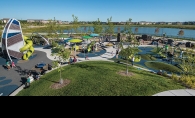In March 2010, Maple Grove Magazine featured a story about the home of Rewati Teeparti and Srinivas Gazula, as they had just installed a geothermal heating and cooling system to create a green, eco-friendly household. Now, their Maple Grove home is sprouting green again as they become a part of the Wright-Hennepin Electrical Solar Panel Community.
Located in Rockford, Minn., the Wright-Hennepin (WH) solar farm is the perfect alternative for those who want to use solar energy in their home but can’t add the panels on their roof. “The [neighborhood] association would not allow us to put solar panels directly on the roof,” Gazula says. “They said it would destroy the beauty of the house.” Then, two years ago, WH built their solar farm and the Gazula-Teeparti household was given a new option: Invest in the solar panel farm.
They paid a lump sum for the panels needed to power their home, and now get kilowatt hours of credit when the panels generate more energy than the home needs. And, sticking to it for the long-run has benefits. “Since they are giving me credits on the kilowatt hours, and in, say, five years, the electricity rates for kilowatt hours increases, I’m not affected [by the increase],” Gazula says.
While it sounds like the perfect setup, Gazula says, “It did require some investment, so people need to think about that, obviously. The second thing is, it’s a long return. So it takes anywhere from 15 to 20 years to get that investment back.” But there’s a benefit to having the solar panels off-property. If he and Teeparti move, as long as they are in the WH electric area, they can keep their credit going. And if they move outside the area, they can sell the solar panels to the prospective buyer of the house, or someone else within the WH electric area.
Having the solar farm, as opposed to having roof panels, removes the risk of installations and reselling the home, as some people may not want to buy a home with solar panels already installed. And, you don’t have to live in a single-family home to be a part of the solar farm community.
“You could be living in a condominium downtown and you could invest in this, or you could be living in any senior high rise apartment and be investing in this,” Teeparti says.
Though we tend to get the winter doldrums due to the cold, Minnesota is actually a great place for collecting solar energy, as the sun shines here more often than in other states. Of course, “there are people in other places, like Arizona, where the sun is [brighter],” Gazula says. “They actually get money back because they generate so much electricity.”
With the solar electricity working for about two years now, and the geothermal heating and cooling in place for five, the Gazula-Teeparti household is a great example of how living green can work. “The geothermal is working great,” Gazula says. “The best part is, during the summer, it really keeps the house cool. We don’t even have an AC unit.” In the winter, however, they do still need to use the furnace. “It can’t keep up with the Minnesota cold.”
Even with the few items that might deter some from going green, like the long return on solar investment, and geothermal not keeping up with the cold (who can?), Gazula and Teeparti find the benefits far outweigh the costs. “We believe in the green energy,” Gazula says.









